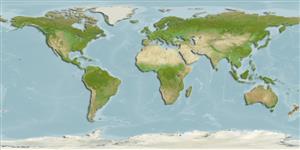>
Gobiiformes (Gobies) >
Thalasseleotrididae (Ocean sleepers)
Etymology: Thalasseleotris: Greek, thalassa = the sea + The name of a Nile fish, eleotris (Ref. 45335); iota: Name from the Greek word 'iota' meaning very small, referring to its size..
More on authors: Hoese & Roberts.
Environment: milieu / climate zone / depth range / distribution range
البيئة
بحري مرتبطة بالشعاب; نطاق العمق 2 - 34 m (Ref. 57647). Tropical
Southwest Pacific: New Zealand.
الحجم / وزن / العمر
Maturity: Lm ? range ? - ? cm
Max length : 3.3 cm SL ذكر/ مختلط الجنس; (Ref. 57647)
وصف مختصر
الوصف الخارجي | قياسات المظهر الخارجي
الأشواك الظهرية (المجموع): 7 - 8; الأشعة الظهرية الناعمة (المجموع): 8-10; شوكة شرجية 1; أشعه شرجية لينه: 7 - 9. Diagnosis: This species differs from T. adela Hoese & Larson, 1987, in having a narrower gill opening, extending forward to below posterior margin of eye or slightly behind eye (vs. under middle of eye); less extensively scaled body, with naked area reaching to below second dorsal origin or beyond (vs. near end of first dorsal fin); higher transverse scale count (usually 7 - 8 vs. 6 - 7); modally lower vertebral count (10+16 vs. 10+17); anterior nasal tube distinctly longer than posterior nasal tube (vs. subequal); two anal pterygiophores before first haemal spine (vs. 1); uppermost scale and lowermost scale on base of caudal fin with enlarged peripheral cteni (vs. no enlarged peripheral cteni). There are several color differences, including: lacking a black spot posteriorly on the first dorsal fin; usually 5 - 6 small black more or less rounded spots on the ventral midline of the caudal peduncle (vs. usually 4 horizontally elongate black spots); a broad black or dark brown area on basal third of pectoral fin (vs. no distinct black area or a small black spot dorsally on proximal upper 2 - 3 rays); dorsal, anal, and caudal fins with thin wavy grey lines (vs. uniformly pigmented); and no dark dorsomedian line on band before first dorsal fin (Ref. 57647).
Observed to be solitary and possibly, a territorial species. Inhabits broken rocky reefs with holes, crevices, and small caves; perches on rocky ledges partly overlain by silty sand or shell debris. Reported to be often collected underwater sharing caves with much larger black gobies Gobiopsis atrata. Its small size, cryptic habit, semi-transparency, and camouflage coloration make this fish very difficult to locate underwater; though readily collected with rotenone ichthyocide while scuba diving. The habitat of this species in New Zealand is very similar to that of T. adela in Australia, which is restricted to rocky reefs, often in silty turbid waters, at 1-24 m depth. May be collected using slurp gun or hand collected following controlled use of rotenone ichthyocide (Ref. 57647).
Life cycle and mating behavior
النضج | التكاثر | وضع البيض | بيض | الخصوبة | Larvae
Hoese, D.F. and C.D. Roberts, 2005. A new species of the eleotrid genus Thalasseleotris (Teleostei: Gobioidei) from New Zealand coastal waters. J. R. Soc. N. Z. 35(4):417-431. (Ref. 57647)
IUCN Red List Status (Ref. 130435)
استخدامات بشرية
مزيد من المعلومات
الأسماء الشائعةمرادفاتالأيضمفتريساتعلم السميات البيئيةالتكاثرالنضجوضع البيضتجمعات وضع البيضالخصوبةبيضتطور البيضة
العمر/ الحجمنموالطول-الوزنالطول-الطولالطول- التردداتقياسات المظهر الخارجيالوصف الخارجيLarvaeحركة انتقال اليرقاتتوظيفالوفرةBRUVS
مراجعالأستزراع المائيملف الأستزراع المائيسلالاتجينيElectrophoresesالتوريثالأمراضمعالجةNutrientsMass conversion
المتعاونينصورStamps, Coins Misc.اصواتالتسمم باكل السمكسرعةنوع السباحةمنطقة الخياشيمعظمة الأذندماغرؤية
أدوات
تقارير خاصة
Download XML
مصادر علي الأنترنت
Estimates based on models
Phylogenetic diversity index (Ref.
82804): PD
50 = 0.8750 [Uniqueness, from 0.5 = low to 2.0 = high].
Bayesian length-weight: a=0.00389 (0.00180 - 0.00842), b=3.12 (2.94 - 3.30), in cm total length, based on all LWR estimates for this body shape (Ref.
93245).
مستوى غذائي (Ref.
69278): 3.1 ±0.4 se; based on size and trophs of closest relatives
Fishing Vulnerability (Ref.
59153): Low vulnerability (10 of 100).
